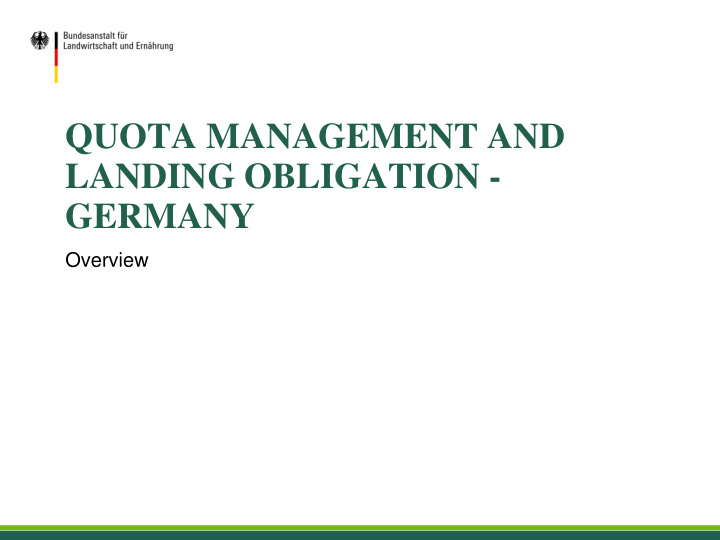



QUOTA MANAGEMENT AND LANDING OBLIGATION - GERMANY Overview
Quota allocation → Fisheries in competence of Federal Ministry of Food and Agriculture → German Fishing quotas managed by the Federal Office for Agriculture and Food in Hamburg on the basis of the Sea Fisheries Act. → Co-management according to the Sea Fisheries Act: Prior to the final decision regarding the quota allocation, the professional associations, fishing companies if appropriate, and the Laender (Federal States) concerned are consulted. → The final allocation remains in the office’s discretion with the right of the beneficiaries to file an objection.
Fishing permits → General permits via publication (e.g. only by-catches, quarterly amounts, fisheries with unlikely use of full quota) and/or → Individual fishing permits → Collective permits for most important stocks for producer organisations. → Producer organisations (may) act as public authority • If so, they are responsible for issuing individual fishing permits for their members within the limit of the collective permit.
Choke species/ stocks – landing obligation → Existing “Tool box” for Member States: • National management and e.g. use of special conditions in TQR-regulations, quota transfer Reg. 847/96 • Quota swaps with other Member States • Technical measures/ area avoidance schemes • Discard plans: de-minimis or high survivability • New with Art. 15 BReg. for certain stocks: Interspecies flexibility or inter annual flexibility
Choke species/ stocks – landing obligation → TAC uplift 2016 only according to quota share of the species stock, i.e. no solution for MS without quota share or insufficient quota → TAC uplift and “Tool box” is not sufficient for full implementation of the landing obligation from 2019 on onwards!
Next steps towards 2019 at EU level 1. Alternatives for TAC-management for stocks with 0- TAC or very low TACs (e.g. spurdog) 2. Alternatives for management of stocks with precautionary TACs (e.g. skates/rays, turbot/brill) 3. Alternatives for Member States with no quota but by- catches in target fisheries (e.g. boarfish) 4. Alternatives for management of fish stocks spreading over several management areas (e.g. hake northern stock)
Next steps towards 2019 at EU level 1. Alternatives for TAC-management for stocks with 0-TAC or very low TACs (e.g. spurdog) 2. Alternatives for management of stocks with precautionary TACs (e.g. skates/rays, turbot/brill) → Abolition of 0-TACs/very small TACs and precautionary TACs and their substitution by by-catch rules combined with move-on obligations in case of exceeding values → For species with high survivability possibility of for discarding as established in discard plans → On EU-level by-catch ratios/ percentage for target stock/ stocks or directly per haul
Next steps towards 2019 at EU level 3. Alternatives for Member States without quota but by- catches in target fisheries (e.g. Boarfish, WHG/03A,....) → Besides TAC a new special condition including BOR for MAC-stocks MAC/2CX14- and MAC/8C3411 (in place already for JAX/4BC7D and JAX/2A-14) → Example JAX/4BC7D: “ Without prejudice to the landing obligation, catches of boarfish, whiting and mackerel may be counted against up to 5 % of the quota (OTH/*4BC7D),…” → Example MAC/2CX14- : “ Without prejudice to the landing obligation, catches of boarfish may be counted against up to 5 % of the quota (OTH/*2CX14- ),…”
Next steps towards 2019 at EU level 4. Alternatives for management of fish stocks spreading over several management areas (e.g. hake northern stock) → Flexibility between quota stocks when the same biological stocks are concerned (amounts of HKE/571214 can be fished in HKE/2AC4-C since it is the same fish stock. Why not vice-versa?) → Example SC for HKE/2AC4-C new in TAC- reg. 2016: “ Not more than 10 % of this quota may be used for by-catch in IIIa (HKE/*03A.)”. → Needed new SC for HKE/2AC4-C: Not more than 10 % of this quota may be used for by-catch in 571214 (HKE/*571214.)”.
Next steps towards 2019 national level → Art. 16.7 BReg: „… Member States shall take account of the likely catch composition of vessels participating in such (, mixed ”) fisheries. → At national level: • Intensifying co-management and further adjusting catch regulations according to availability of quota and need of the industry. • Replacing quantitative catch limitations to non-quantitative limitations such as “ only by-catch allowed ” to avoid discards in the first place. • Permitting by-catches of TAC-stocks in main (economically most important) target fisheries is priority. Quota reserves/by-catch allocations at national level will affect quotas for target fisheries. Quota allocation for a certain target fishery may cease.
Example Baltic Sea → Since autumn 2015 no directed salmon fishing allowed. The whole German quota is reserved for by-catches in cod/ pelagic fisheries. • In 2016 two fishing companies applied for allocation of salmon for directed fishing. The applications were rejected. Objections were filed against the decision.
→ Thank you very much! www.ble.de
Recommend
More recommend